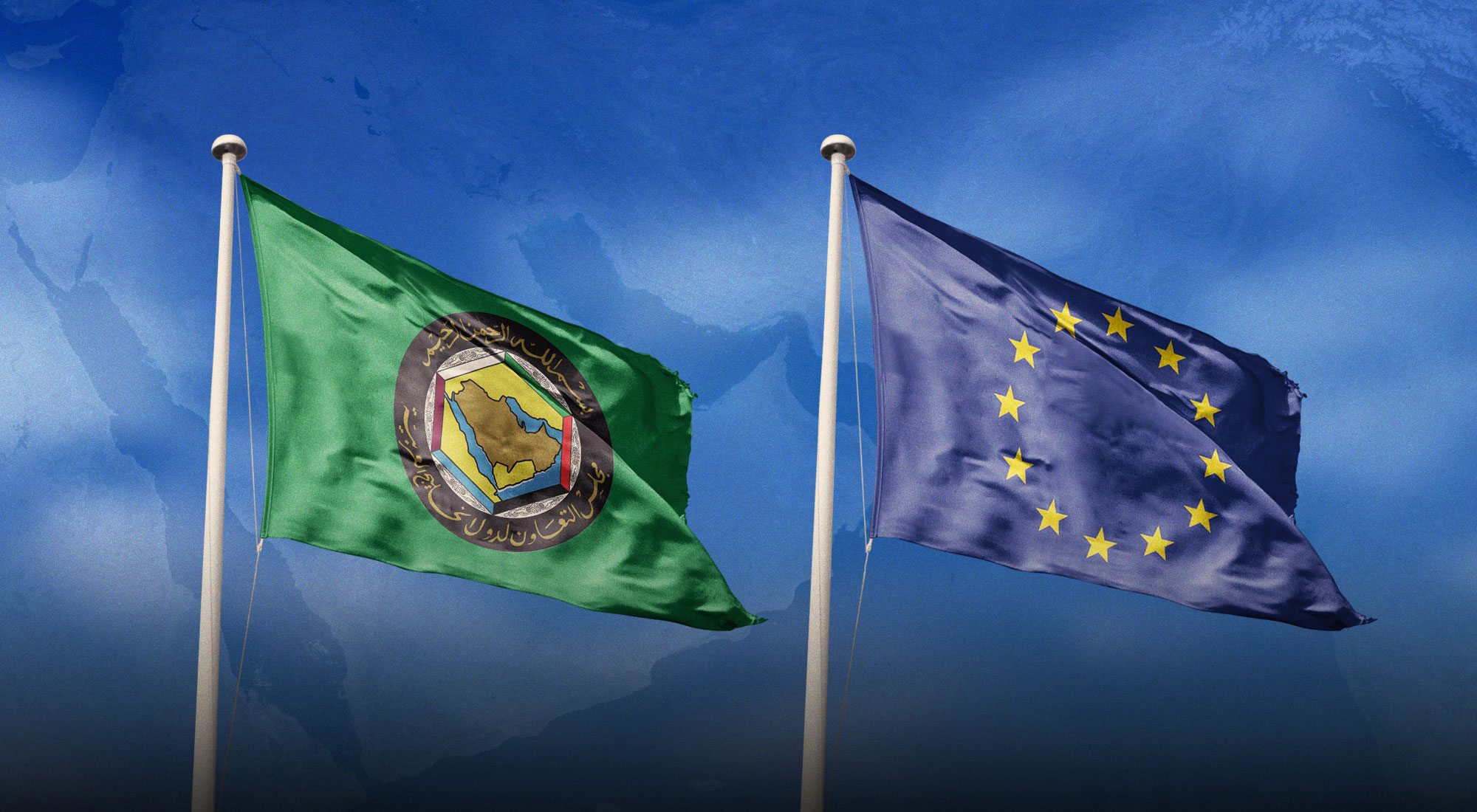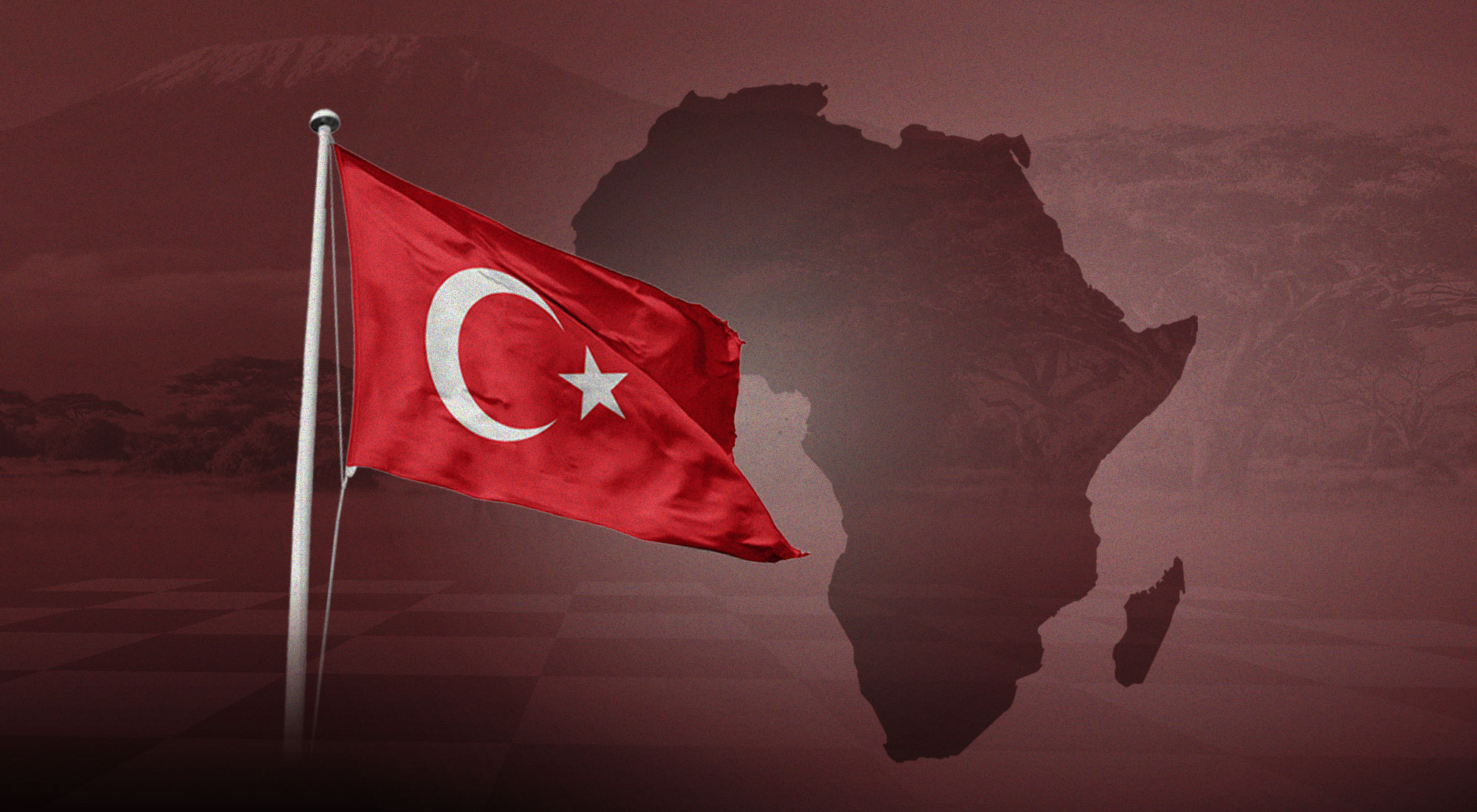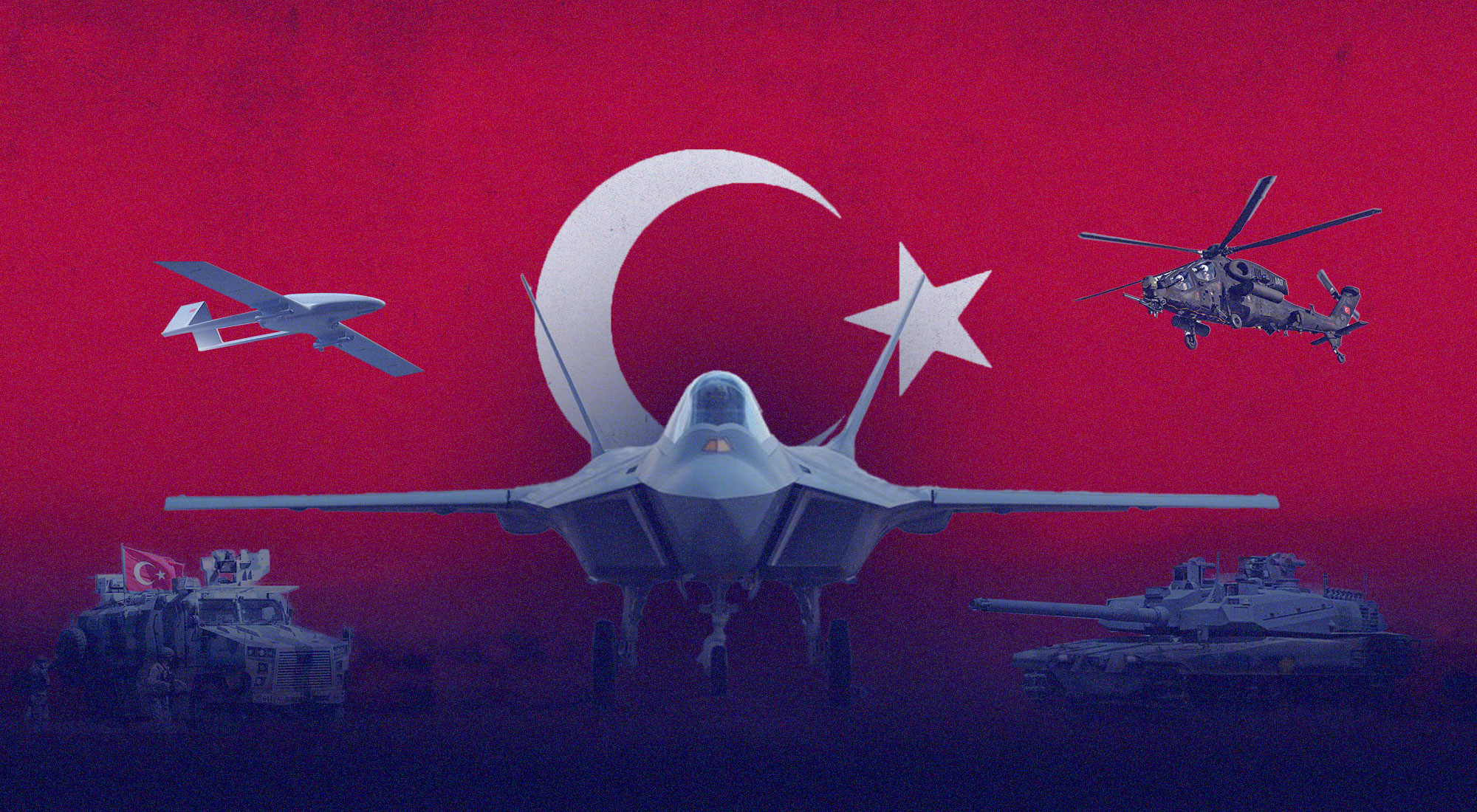The Iraqi army launched a complex operation in Nineveh province in April 2022,[1] with the aim of restoring Baghdad’s authority in this unstable “red zone”.[2] While the 15th and 20th Infantry Divisions have received reinforcements, ammunition, and artillery, General al-Khafaji of the Joint Operations Command has stated that Iraq “will not allow any forces outside the Iraqi state perimeter in the Sinjar district.”[3]
Baghdad is responding or reacting to the latest attack by the Turkish army. Ankara initiated Operation Claw-Lock to hunt down the PKK in Iraqi territory, the objective being to prevent Iraqi Kurdistan, already autonomous, from becoming independent. The Turkish army has about 40 bases and outposts in this region, operating since the 1980s.[4] Its attacks are concentrated on the localities of Zap, Avashin-Basyan, and Metina, forcing Kurdish independence fighters to withdraw. Thousands of civilians are fleeing the fighting[5] and abandoning villages,[6] while farms and forests are being destroyed.[7]
The Iraqi government has repeatedly warned Ankara to stop violating its border[8] in the name of the “right to pursue” PKK independence fighters.[9] The Iraqi government rejects the thesis that Ankara is coordinating operations with Baghdad. For them, it is territorial aggression.
The Iraqi military operation was conducted along two lines. The first involves military action. Troops were deployed in the Sinuni district to affirm a state presence in this PKK stronghold. The army captured the Hittin compound and several roads.[10] Twenty-seven Iraqi soldiers were wounded in the clashes and two others were abducted by the Sinjar Resistance Units militia, which is the independent Kurdish wing of the PKK.
The second is based on political motives. Baghdad wants to restore trust with the local population. Major General Jabar Al-Tayi, Commander of the West Nineveh operations, and Brigadier General Atheer Al-Zubaidi, Commander of the 20th Division,[11] held meetings with Sinjar notables to reassure the community.[12] The misunderstandings and resentments are old. Four events have progressively distended relations between Bagdad and the people of Nineveh.
- In 1977, Baghdad forced the Yazidi minority of Kurdish origin to register in the national census as Arabs.
- In 2003, the “de-ba’athification” of the Iraqi administration increased unemployment in Nineveh province and the feeling of neglect.
- In 2014, the Islamic State group attacked the province. The Iraqi army retreated without combat and abandoned the population.
- In 2020, the Sinjar agreement provided for a division of responsibilities between Baghdad and the Kurdistan Regional Government,[13] where the mayors of Sinjar and Mosul were to be elected by a joint committee and a new 2,500-member security force was to secure the region and remove the PKK. The agreement was never implemented.
A long-term war
The Iraqi army has launched a long-term operation. For the moment, the PKK is avoiding direct military confrontations. It is slowing down the progress of Baghdad forces by dumping mounds of earth on the roads in the Bab Shilo.[14] The Kurdish fighters, about 3,000 men, have retreated to the Zab Mountains and the Qandil mountain range. Sources close to Iraqi military intelligence, unconfirmed by independent sources, report tactical withdrawals toward the south.[15]
Yazidi independence fighters are not monolithic. The Yazidi Popular Mobilization Forces has four units of 150 men (79th Regiment, 4th Regiment, Kocho Martyrs, Lalish Regiment). Three groups are aligned with the PKK: Sinjar Resistance Units (YBŞ), Êzîdxan Women’s Units (YJÊ), and the Asayish Êzidxan.[16] While the province has long been dominated by the Kurdistan Democratic Party (KDP) – the party recognized by the autonomous administration of the province – reports[17] note the rise of this ecosystem of Kurdish independence movements.[18]
While the YBŞ is an extension of the PKK, its members are Yazidis, an Iraqi ethnoreligious minority whose beliefs date back to ancient Iran.[19] Persecuted by the Islamic State group in 2014,[20] these populations have never forgiven the Iraqi army for abandoning them in the face of ISIL’s lightning offensive. Only the PKK intervened to create a humanitarian corridor and protect civilians. The YBŞ denounced the recent Iraqi military operation as it suspects Baghdad of colluding with the Turks to marginalize them.[21] According to Ali Serhan Eissa, a commander of the Lalish Brigade of the Yazidi Hashd al-Shaabi, “the Iraqi state hasn’t considered us first-class citizens since 2003,[22] and Kurdistan sells us every few years for [KDP] interests based on what’s happening between it and Baghdad.”[23]
The YBŞ has already been involved in small-scale fighting with the Iraqi army.[24] Despite resentments, Baghdad wants to avoid an escalation. The YBŞ are Iraqi. Unlike the PKK militants, they cannot be driven out. All belligerents are aware of this. The General Command of the YBŞ states: “We are not against the Iraqi army, but we are against the policies of liquidation and the use of the Iraqi army to carry out the agendas of certain external powers.”[25]
Regional powers
The intervention of the Iraqi army is a reminder that Nineveh should not be turned into a battlefield between two regional powers: Turkey and Iran.
Ankara is engaged in intense regional diplomacy with the Kurdistan Democratic Party (KDP) – the most powerful political party in Iraqi Kurdistan – and the Kurdistan Regional Government (KRG). All have a common enemy: the PKK. This relationship allows the Turks to contradict Baghdad’s claim that the PKK is a pretext for President Erdogan’s neo-Ottoman ambitions, this posture of viewing the geopolitics of the Middle East through the nostalgic eyes of its fallen empire.
In addition to military bases housing between 8,000 and 10,000 men, Turkish patrols crisscross the areas where PKK camps are located, such as Hakurk, Haftanin, Metina, Zap and Avashin-Basyan. The obligation to limit its actions to a depth of 5 to 10 kilometers has never been observed. Turkish F-16s have struck targets in Sinjar, about 160 kilometers from its border, and in the Makhmour area, 218 kilometers to the south.[26]
The deployment of Bayraktar TB2s drones have made it easier to monitor a rugged theater of operations, steep cliffs (Zagros), snow-capped peaks (Qandil), as well as numerous tunnels[27] and natural hiding places[28] of the PKK. The combination of drones and HUMINT (Human Intelligence) has tightened the noose around the Kurdish leadership and reinforced the effectiveness of Turkey’s targeted strikes against PKK infrastructure and leaders.[29]
The Turkish strategy is officially aimed at stopping the expansion of the PKK in northern Iraq so that its regional capital, Sinjar, does not become “another Qandil”, referring to the mountain range of the PKK headquarters. Its approach to Nineveh is global. Ankara wants to facilitate the establishment of Turkish companies in the region and negotiate a new energy agreement with the Kurdistan Regional Government. Since the Russian war in Ukraine, the Turks have been seeking to diversify their energy portfolio. The recent discovery of natural gas to the south and east of Kirkuk has increased its interest in the region.
Turkey considers its actions to be legitimate, unlike the other major player in the region: Iran. However, there are strategic similarities between the two countries. Like Ankara, the Iranian authorities want to establish their influence in the border triangle (Iraq, Syria, Turkey), which is a hub for fighters, activists hostile to the Islamic Republic, and traffickers who thrive on the trade of consumer goods and drugs. Again, like Ankara, Tehran has officially stated that it will not tolerate the activity of terrorist groups on its northwestern border. While the Islamic Revolutionary Guard Corps (IRGC) is deploying forces on the ground, five militants who were planning to carry out hostile actions on Iranian soil have already been arrested in the city of Baneh.[30]
Iran is backing the policy of Iraqi Prime Minister Mostapha el-Kazemi, who is committed to reestablishing his authority in the north of the country, in coordination with the autonomous Kurdish authorities. On the one hand, the approach is political. It aims to express Iranian solidarity on an issue of sovereignty. Iraq is not only an ally, but also a nation in which Iran is developing its soft power (political entryism, opening of economic borders, military support). On the other hand, it is military. The Iraqi militia’s pro-Iranians use the opportunity to remind all that they are fighting in the national interest.[31] The Al-Nujaba and Asa’ib Ahl al-Haq groups affiliated to Hashd al-Shaabi (Popular Mobilization Brigade) have expressed their willingness to confront Turkey if its influence continues to expand, while Iraqi militias are threatening to attack Turkish forces rather than American troops stationed in the country, and strike directly the Turkish economy.
Iran’s analysis of Nineveh province is not confined to border violations. Its concern is the regional ambitions of Turkey, which claimed the vilayet (province) of Mosul when its borders were established in 1923. The rejection of this claim is a scar that has not been forgotten. Northern Iraq was “forcibly separated” from Turkey, Turkish Defense Minister Sabahattin Cakmakoğlu said in August 2002.[32] The regularity of Turkish operations raises fears of a Syrian-style scenario with provinces under full Turkish control.[33] Ankara’s armed forces support coalitions of armed groups (the Syrian National Army – SNA) and are interlocutors of powerful armed groups, such as Hayat Tahrir al-Sham in Idlib.
Reliable sources, confirmed by U.S. intelligence,[34] report Iranian activities in the province to fend off Turkish expansionism. Iraqi paramilitary groups (supported by Iran) have approached the PKK, which considers the Yazidis as members of the Kurdish nation. Pasdaran forces intervened on the field. The Iranian Revolutionary Guard Corps (IRGC) engaged in large-scale operations by conducting a ballistic missile attack on the Kurdish regional capital of northern Iraq, Erbil.[35] Although the objective of this strike is unclear, a message has been sent: Iran is a committed player in the region. Tehran has three aims:
- To improve its image in Iraqi public opinion as a defender of Iraqi sovereignty and demonstrate that Iran is not an invading force but one that supports the Damascus regime.
- To contain the neo-Ottoman policy of President Erdogan by establishing red lines that should not be crossed.
- To demonstrate to the Iranian public that the spirit of the revolution is in perfect adequacy with the political and security challenges of the Middle East.
ISIL: A latent threat
This latent conflict with multiple protagonists is benefiting the Islamic State group. Fighters are active in the “security neutrality” zones situated between the Kurdish Peshmerga and the Iraqi army. They carry hit and run operations in small units of 10 to 15 men to support themselves and conduct small-scale operations.[36]
The residual presence of ISIL dates back to 2014, a cursed year for the Yazidis. Islamic State fighters took control of key points in the province within 72 hours. Villages were emptied, women were abused[37] and those accused of being heretics and polytheists were exterminated. The death toll stands between 2,000 and 4,000.[38] As Iraqi forces withdrew without a fight, leaving the Yazidis defenseless, the PKK stepped in to save civilians. The Yazidi oral tradition has established a calendar of its persecutions; the Sinjar massacre is the 74th ferman (catastrophe).[39]
The Peshmerga continue the anti-terrorism fight against ISIL caches. A 150-meter-long tunnel was recently uncovered in the Al-Namrud sub-district,[40] and targeted strikes are continuing to prevent the group from regaining its operational capability. Lately, Iraqi aircraft have destroyed vehicles carrying radical activists.[41]
The province of Nineveh presents a double security challenge for Baghdad as in restoring order in the autonomous province and preventing the resettlement of terrorists. These tasks are complicated by the political context. Iraq has not elected a president and a prime minister since the parliamentary elections in October 2021. The Sadr bloc that won in the elections is not able to form a government. Current affairs are being handled by the Iraqi Prime Minister Mustafa Al-Kazemi and the former administration.
This situation, where the temporary becomes permanent, affects the authority of Baghdad. On fundamental issues, there is real convergence with the autonomous authorities. Leader of the Kurdistan Democratic Party, Massoud Barzani, rejects the presence of foreign forces (PKK, Turkey, IRCG, ISIL).[42] However, in everyday political life, some decisions from Baghdad are contested. Al-Kazemi’s choice to appoint Najm al-Jubouri, the former governor of Nineveh, as mayor of Sinjar district, was dismissed by the regional authorities as an intrusion into their internal affairs.[43]
The Iraqi army’s operation in April is a warning that Baghdad will not compromise on its interests in the region – political, of course, but also economic. Iraqi Oil Minister Ihsan Abdul-Jabbar has announced plans to create a new oil company,[44] following the Federal Supreme Court’s ruling that the 2007 Iraqi Kurdistan Oil and Gas Law has become “unconstitutional” on the basis that it violates constitutional provisions.[45] The KRG has formally challenged this decision[46] but the matter remains unresolved. Both sides suspect each other of wanting to take control of fossil resources.[47]
The challenge for Prime Minister al-Kazemi is to maintain leadership on this issue. Sending the army to Nineveh is an act of sovereignty, a matter of taking back the initiative so that this province does not become a marginalized region for two neighboring powers, Iran and Turkey, to clash.
Baghdad is at the epicenter of two trends. On the one hand, Ankara is trying to get closer to the Sadr Bloc, the winner of the last legislative elections.[48] Its entryism is exerted on the economic front – 70% of Iraqi-Turkish trade flows ($20 billion) pass through Kurdistan.[49] On the other hand, Iran is pursuing a long-term strategy of influence in Iraq. The dynamics of bilateral relations ease the current political transition period and Tehran’s close ties with the militias help protect it from criticism from Turkey.[50] Both countries suspect each other of hegemonic ambitions.
However, the political sensitivity of the next Iraqi government is yet to be determined. The operational largesse that Iran grants itself in Iraq is not unanimous, nor is its privileged relationship with the armed groups that relay its discourse. Naim al-Aboudi, the leader of the Iraqi armed coalition Asa’ib Ahl al-Haq, for one, has called on the Iraqi government to commit “all means” necessary to stop these foreign intrusions.[51]
The main unknown remains the ability of the Iraqi army to carry out its current operation in Nineveh, where violence is unpredictable and uncertainty is permanent. Its troops are already stretched thin by counter-terrorism operations in the Diyala and Dhi Qar regions. U.S. backing is no longer an option since Baghdad and Washington reached an agreement to end U.S. combat operations.[52] Its first challenge is to sustain the military effort over time. The second is to impose the 2020 agreement by force, without escalating the violence.
References
[1] “Iraq: Displacement from Sinjar due to Battles between the Army and ‘Al Yabsha’,”Al Arabia [Arabic], May 3, 2022, https://cutt.ly/8HN3JdM.
[2] The term “red zone” originated with the American intervention in Iraq in 2003 to designate dangerous regions.
[3] “The Iraqi Army Recaptures Sinjar from Loyalists to the Turkish ‘Workers’,” Asharq al Awsat [Arabic], May 4, 2022, https://cutt.ly/vHN4jtn.
[4] Turkey’s first cross-border operations in Iraq took place in 1983, 1986, and 1987. An agreement signed with Saddam Hussein in 1984 allowed both sides to conduct military actions to a maximum depth of 10 kilometers and for three days. See, Özhan Hancılar, “1983-1987 Kuzey Irak’taki Türk Sınır Ötesi Operasyonlarının Hukukîliği“, Pamukkale University Journal of Social Sciences Institute, no. 46 (December 2020), https://cutt.ly/MH4gZCu.
[5] Safa Al Kubaissi, “Sinjar Clashes Push Hundreds of Iraqi Families towards the Camps and the Open,” Al Arabi [Arabic], May 3, 2022, https://cutt.ly/8H64Vwn; “Sinjar Clashes Force 4 Thousand Yazidis to Flee Again,” Independent Arabia [Arabic], May 3, 2022, https://cutt.ly/hH5vDbP.
[6] Amedi and Duhok District.
[7] Satellite image of tree destruction: https://cutt.ly/kHX5S7I.
[8] “The Ministry of Foreign Affairs Denies Ankara’s Allegations about Coordination Regarding Its Military Operations,” Iraqi News Agency [Arabic], April 24, 2002, https://cutt.ly/8H2Yot8.
[9] Turkey is conducting transnational military operations under Article 51 of the UN Charter on “self-defense” against the PKK. Over the past two years, the pace of attacks has increased. The Turkish military launched Operation Claw Lock on 17 April 2022; operations Claw Lightning and Claw Thunderbolt in 2021; and operations Claw Eagle and Claw Tiger in 2020.
[10] The 20th and 15th Iraqi Army Divisions, and the 9th Armored Division were engaged in these operations.
[11] A division is composed of 14,000 soldiers divided into four brigades.
[12] Dler S. Mohammed, “‘We Will Not Allow PKK to Stand in the Army’s Way’: Iraqi Commander,” Kurdistan 24, May 6, 2022, https://cutt.ly/YHX68Cj.
[13] The Sinjar agreement was signed on October 9, 2020.
[14] “To Impede the Progress of the Iraqi Army, Workers Block Roads of Sinjar with Earth Mounds,” Shafaq [Arabic], April 25, 2022, https://cutt.ly/tH5x46v.
[15] Daren Butler, “Turkish Warplanes Attack Kurdish Fighters in Iraq, Syria,” Reuters, February 2, 2022, https://cutt.ly/GHX9pd3.
[16] Two groups support the Kurdistan Democratic Party (KDP) headed by Netchirvan Barzani: Sinjar Command (2,000 fighters led by Qasim Shesho) and Protection Force of Ezidxan (500 fighters led by Haider Shesho). See, Abdulla Hawez, “The Coming Sinjar War,” Notes from Kurdistan, April 1, 2021, https://cutt.ly/RJm9LjH.
[17] U.S. Department of Defense, Operation Inherent Resolve: Lead Inspector General Report to the United States Congress (January 1, 2022 – March 31, 2022), https://cutt.ly/yH7qNS8.
[18] PKK had promised to leave Iraq in 2018. It never kept its word. See, “Kurdish Militant PKK Group Withdrawing from Iraq’s Sinjar-Firat News Agency,” Reuters, March 23, 2018, https://cutt.ly/RJoovYq.
[19] The province of Nineveh is also inhabited by Sunni Arab, Shiite Turkmen and Shabak populations, and some Christian communities.
[20] Wendy Cook, Tom D. Kennedy, Ron Chenail, David Detullio & W. Alex Edmonds, “Exploring the Shared Experiences of Yazidis Who Survived Genocide,” Journal of Trauma & Dissociation 23, no. 4 (October 2021), https://cutt.ly/eJoPW0H.
[21] According to a YBS release: “Al-Kazemi’s government carried out these attacks on the orders of the Turkish state.” See, “The Sinjar Resistance Issues a Statement on the Situation of the Judiciary: We Will Protect Ourselves,” Bagdad Today [Arabic], April 3, 2022, https://cutt.ly/9H7rFpj.
[22] After the fall of Saddam Hussein, the Governing Council of Iraq and the American administrator Paul Bremer established a provisional Basic Law on November 15, 2003, which, according to the Yazidis, favored the Kurds. Article 4 of this text, confirmed in 2004, defines Iraq as a federal republic in which political power is shared between the capital (Baghdad) and the regions and governorates on a geographical basis and not on an ethnic basis. See, “Irak : situation sécuritaire dans le district de Sinjar,” OSAR-Berne, November 28, 2018, https://cutt.ly/XKHjlXo.
[23] “Al-Yabsha and the Army ‘Exchange Prisoners’: The People of Sinjar Call for Calming the Situation in the Judiciary” Kirkuk Now [Arabic], April 25, 2022, https://cutt.ly/xJsL31G.
[24] “Yezidi Convoy Says It Was Ambushed by Iraqi Army in Shingal,” Rudaw, March 18, 2019, https://cutt.ly/8JsCtL1.
[25] “YBŞ: Determined to Defend Land and Gains,” Hawar News Agency, May 3, 2022, https://cutt.ly/8JyaqRL.
[26] Fehim Tastekin, “Turkey May ‘Lock’ Borders with Syria and Iraq to Deal with Kurdish Militants,” Al Monitor, April 27, 2020, https://cutt.ly/kJlY83m.
[27] “Terör Örgütü PKK/YPG Kazdığı Tünellerin İçine Hücreler İnşa Ediyor,” TRT Haber, May 27, 2022, https://cutt.ly/RJlPjHe.
[28] Muhammet Kutlu, “Sincar İkinci Kandil Olmayacak,” Yeni Akit, May 21, 2022, https://cutt.ly/nJlURZK.
[29] For example, a member of the PKK’s executive central committee, known as Haydar Varto, was killed in Qamishli in September 2021: https://cutt.ly/7JvGm8j.
[30] “Iranian Military Target Terrorist Sites in Iraq’s Erbil,” Al Bawaba, May 12, 2022, https://cutt.ly/DH5Y7Sp.
[31] According to Shafaq news agency, the first pro-Iranian militias in Nineveh province deployed in 2018 “consist of three brigades of the popular mobilization with their equipment and mechanisms, in addition to the formations of Asa’ib Ahl al-Haq and Hezbollah, which were all stationed in the camp of Domiz in Sinjar. They moved under the leadership of PMF Chief of Staff Abdul Aziz al-Muhammadawi (Abu Fadak). See, “Brigades of the Popular Mobilization and Two Shiite Factions Move ‘by Surprise’ towards the Sinjar Front ,” Shafaq [Arabic], June 23, 2022, https://cutt.ly/UJl8Oit.
[32] International Crisis Group, “Turkey and Iraqi Kurds: Conflict or Cooperation?” Middle East Report, November 13, 2008, https://cutt.ly/QJmCcwE.
[33] Hoda Raouf, “Northern Iraq: Sinjar Is a Major Front for Turkish-Iranian Competition,” Independent Arabia [Arabic], September 11, 2021, https://cutt.ly/iJl9cu0.
[34] “The Pentagon: The Iraqi Factions Loyal to Iran Are Coordinating with the PKK against Turkey,” Syria TV [Arabic], May 5, 2022, https://cutt.ly/2JvAYMz.
[35] “A Tough Iraqi Position against Iran and the Recall of Its Ambassador in Baghdad,” Independent Arabia [Arabic], March 13, 2022, https://cutt.ly/7JQeO9U.
[36] “Gaps between Iraq and Syria That ISIS Exploits to Return,” Al Ghad [Arabic], February 11, 2022, https://cutt.ly/mJyTPwI.
[37] Nussaibah Younis, “How Isis Has Established a Bureaucracy of Rape,” The Guardian, August 16, 2015, https://cutt.ly/nJQmoRq.
[38] “On the Frontlines against Genocide,” Yazda, https://cutt.ly/2JQm1ow.
[39] Ferman is a term that referred to a decree of the Sublime Porte. The 73rd took place in northern Iraq when two car bombs exploded in Qahtaniya and Siba Sheikh Khidir, killing 500 people in 2007. The 72nd Ferman was the Armenian genocide in which the Yezidis were also massacred in 1915-1916.
[40] “150-Meters Long Tunnel Used by ISIS Found in Nineveh,” Shafaq, May 5, 2022, https://cutt.ly/AJRpWa7.
[41] “Iraqi Army Aircraft Bombs a Vehicle Carrying ISIS Militants in Nineveh,” Shafaq, May 7, 2022, https://cutt.ly/AJRain8.
[42] “While Baghdad ‘Denounces’, Ankara Offers ‘Thanks’: ‘Violation’ of Sovereignty Continues,” Al Hurra [Arabic], April 21, 2022, https://cutt.ly/JJRvYEl.
[43] “Political Differences Stop Baghdad’s Move to Solve the Sinjar Crisis,” Independent Arabia [Arabic], April 29, 2022, https://cutt.ly/TJRgHwf.
[44] “The Iraqi Ministry of Oil Aims to Establish a New Oil Company in the Kurdistan Region,” Al Hurra [Arabic], May 21, 2022, https://cutt.ly/fJRPdKY.
[45] The Iraqi Supreme Court issued this ruling on February 15, 2022. See, Federal Supreme Court, “Notice Regarding the Federal Supreme Court’s Decision That the Kurdistan Region’s Oil and Gas Law is Unconstitutional,” [Arabic], February 15, 2022, https://cutt.ly/jJRSEGk.
[46] ”Statement from the Kurdistan Regional Government,” Kurdish Regional Government [Arabic], February 15, 2022, https://cutt.ly/HJRDOuW.
[47] “A Spokesman for the Kurdistan Regional Government Issues a Clarification Regarding the North Oil Company in Kirkuk,” Sotal Iraq [Arabic], May 15, 2022, https://cutt.ly/3JRGCP3.
[48] These moves are taking place in a climate of mistrust. Ankara has not forgotten the Iraqi Parliament refused to vote on a free trade agreement (2009) for lack of guarantees on access to the waters of the Euphrates and Tigris. See, Nimrod Raphaeli, “Water Crisis in Iraq: The Growing Danger of Desertification,” Middle East Media Research Institute (MEMRI), July 24, 2009, https://cutt.ly/fJUoGg3.
[49] Berkay Mandıracı, “Turkey’s PKK Conflict: A Regional Battleground in Flux,” International Crisis Group, February 18, 2022, https://cutt.ly/bJUaf7b.
[50] Turkey’s ambassador to Baghdad, Fatih Yildiz, wrote on Twitter, “Iran’s ambassador is the last person who has the right to lecture Turkey about respecting Iraq’s borders.” See, Hoda Raouf, “Northern Iraq: Sinjar Is a Major Front for Turkish-Iranian Competition,” Independent Arabia [Arabic], September 11, 2021, https://cutt.ly/iJl9cu0.
[51] “While Baghdad ‘Denounces’, Ankara Offers ‘Thanks’: ‘Violation’ of Sovereignty Continues,” Al Hurra [Arabic], April 21, 2022, https://cutt.ly/JJRvYEl.
[52] Steve Holland and Trevor Hunnicutt, “Biden, Kadhimi Seal Agreement to End U.S. Combat Mission in Iraq,” Reuters, July 27, 2021, https://cutt.ly/xKlWVFV.








